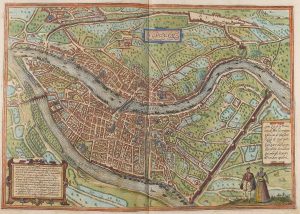Before the temple construction
The reformation began in Lyon in the Vaud community established by Pierre Valdo (1140-1217).
The reformers first occupied the catholic church Sainte-Croix, where they installed an amphitheatre and benches, fixing God’s commandements and the royal coat of arms on the door. In 1563 the national synode of reformed churches was held in Lyon. From 1564, a group of properties was purchased to become a temple. The structure, called « paradise temple », was built in six month.
This name « paradise » was adopted by the reformers because it was surrounded by rows of prominent balconies that looked like paradise. (Almanach of Lyon,1743).
The oldest representation of a protestant temple
The painting « Temple of Lyon named Paradise » which is exhibited in the International Reformation Museum in Geneva is said to be by Jean Perrissin, painted around 1565. This artist from Lyon, refugeed in Geneva is better known for some engravings realized with Jacques Tortorel. The painting shows the beginning of a service, it may be a christening or a wedding.
The painting illustrates a certain number of characteristics of this church community. The comfortable benches for reputable persons depict the social hierarchy. About fifty believers adopt different attitudes : men with their swords, women sitting separated, the presence of children. The hourglass limits the eloquence of the preacher. The dog is often on protestant engravings as a symbol of loyalty but maybe to symbolise deconsecration of temples in the protestant conception.
A protestant architecture
From the central view-point the building has three stairs with two sides which lead to the inside tribunes with galeries all around. A circle and a pointed roof is above the big hall.
The pastor’s pulpit is central to the edifice : the benches are all around in order to be able to hear more easily. On the first floor, the platform is well lit by skylights. The inside decoration on the wall of the superior gallery shows paintings with the royal emblem and the coat of arms of the city.
The plan of the building is focused on a central area enabling the minister to be in touch with the congregation, rather as in a theatre.
However the life of the temple was short-lived: in 1567, the temple was destroyed the day before the Second War of Religion. The road where it was situated conserved the name of „Paradise“.







